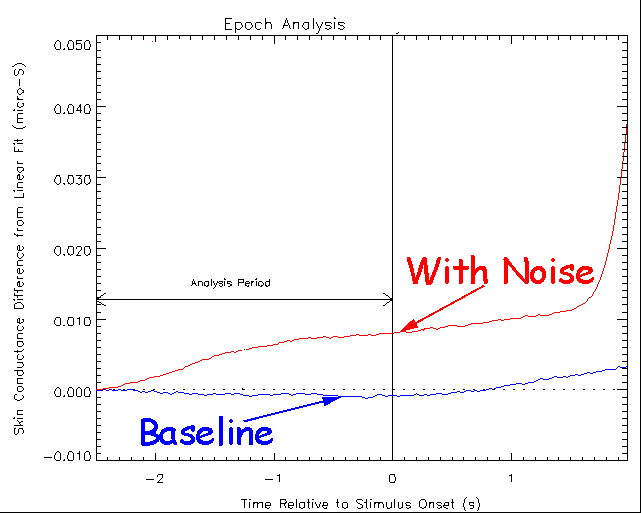



Connections Through Time, Issue 20: July
- September 2003
![]()
"We found a significant effect." - James Spottiswoode and Ed May |
Precognition, the ability to know or sense something before it happens, is not explained by any accepted physical theory. Most physicists dismiss the possibility of precognition, and yet, the scientific evidence continues to accumulate that precognition is real and reproducible.
James Spottiswoode and Ed May have recently completed a study showing that the body can respond 2 - 3 seconds before a loud noise is heard. The noise (1 sec. in duration) was sent to headphones in a random fashion and was loud enough to elicit a "startle response". Skin conductivity histories were measured from a finger (similar to what is measured in a lie detector). Below is a graph summarizing one person's averaged skin conductivity data showing the differences between skin conductivity measurements with and without the noise stimulus. Note the elevated response during the 2.5 seconds before the noise began.

|
|
Averaged
Skin Conductance Results for One Person |
The red curve represents the average response from the 11 times this person heard the startling noise, where time = 0 represents the onset of the noise and t = -2.5 seconds is where the data begins to be compared to the blue baseline curve. The baseline curve is averaged from the 9 times the noise was not sent to the person (there were 20 possible responses measured in this protocol). For this person, the observed difference between the two curves in the 2.5 second "epoch" had odds of occurring strictly by chance of 5.5 to 1 (Z score = 1.025) which by itself is not significant. Combining the results from the group of 120 people led, however, to the significant odds against chance of 1851 to 1 (Z score = 5.4 x 10-4).
The details of the protocol and the analysis can be found in the Spottiswoode/May reference below.During the experiment, the subject is not conscious of any precognitive responses; however, the subject's body seems to know about its noisy-startling future. How much else does the body, with its fantastic nervous system, know?
Body-precognition experiments have previously been done by Dean Radin and D. J. Bierman using a different protocol. Their protocol involved subjects looking at photographs with high vs. low emotional content. Statistically significant results were found in these studies - the measured body responses were a statistical predictor of a future emotional experience associated with the type of photo to be randomly presented.
In these body-precognition experiments, only one small part of the subject's body is being measured by an instrument. And yet this was enough to demonstrate, once again, the reality of precognition. Considering the fact that the body itself is a very sophisticated "instrument", how much else does the body know, and how much can become consciously known?
References
Skin Conductance Prestimulus Response: Analyses, Artifacts and a Pilot Study, by James Spottiswoode and Ed May. Laboratories for Fundamental Research, Palo Alto, CA, To be published in the Journal of Scientific Exploration.
The Conscious Universe, by Radin, D. I. (1997). Harper Edge, Harper Collins, New York, NY.
Unconscious Perception of Future Emotions: An Experiment in Presentiment, by Radin, D. I. (1997). Journal of Scientific Exploration, 11(2), 163-180.
Conscious and Anomalous Non-Conscious Emotional Processes: A Reversal of the Arrow of Time? by Bierman, D. J. & Radin, D. I. (1998). In: Toward a Science of Consciousness, Tucson III. MIT Press, 1999, 367-386.
Anomalous Baseline Effects in Mainstream Emotion Research Using Psychophysiological Variables by Bierman, D. J. (2000). Proceedings of Presented Papers: The 43rd Annual Convention of the Parapsychological Association, 34-47.
Go to another section of
this
issue:
Intuition: